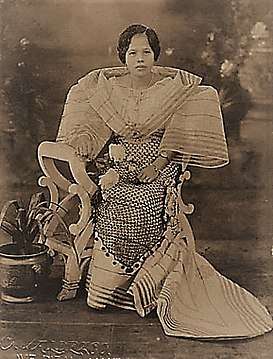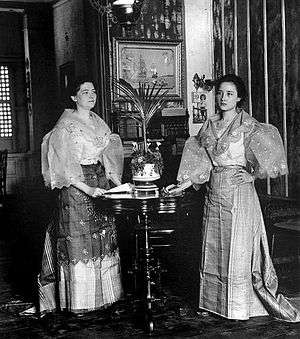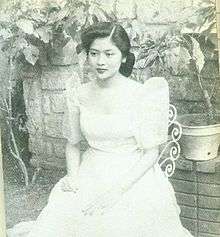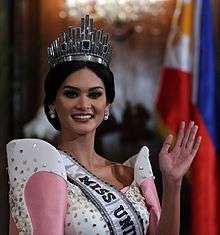Maria Clara gown

The María Clara gown, sometimes referred to as Traje de Mestiza or simply terno, is a traditional dress worn by women in the Philippines. It is a form of the Baro't saya. It takes its name from María Clara, the mestiza protagonist of the national epic Noli Me Tangere, penned in 1887 by Filipino national hero José Rizal. It has been connected to the María Clara character because of her traits: delicate, feminine, self-assured and with a sense of identity. The María Clara outfit is the only Philippine national attire that is named after a literary figure. Like all Baro't Saya it is traditionally made out of Piña, the same with the Barong of Men[1]
Origins

"María Clara" origins came out from the earlier Baro't saya. after the ensemble was associated with the tragic heroine in Dr. Jose Rizal's Noli Me Tangere.[2] The Maria Clara of this period in the late 1800s consisted of 4 components: a camisa (blouse), pañuelo (fichu), saya (skirt), and an optional tapis (rectangular piece of cloth) or an elaborate "dalantal" (apron) [3]
Traditional components

The attire is composed of four pieces, namely the camisa or baro, the saya (Baro't saya), the pañuelo (Spanish for scarf, also spelled panuelo) and the tapis.
The camisa is a collarless blouse whose hem is at the waist, and is made from flimsy, translucent fabrics such as pineapple fiber and jusi. The sleeves of the camisa are similar to the so-called "angel wings", or shaped like bells. The correct term for the sleeves of the camisa during the mid to late 1800s is a "pagoda" - derived from early Western silhouettes of the Victorian period [2] The pañuelo is a piece of starched square cloth (either opaque or made from the same material as of the camisa) folded several times, and placed over the shoulders. The purpose of the pañuelo has been related to modesty, used to cover the nape and the upper body due to the camisa's low neckline as well as its sheer translucency; and also doubles as an accent piece because of embellishments added to it, usually embroideries and the pin securing it in place. The saya is a skirt shaped like a "cupola"[4] with a length that begins from the waist reaching the floor. These are usually comprised either of single or double sheets, called "panels" or dos paños (Spanish for "two cloths"); some examples are made out of seven gores or siete cuchillos (Spanish for "seven knives"). The tapis is a knee-length over-skirt that hugs the hips. Tapis designs may be plain, and is usually made of opaque fabrics such as muslin and the madras cloth, and also is used for the purposes of modesty as it keeps the lower body from showing due to the thinness of the saya[1] and the absence of underwear.
Some ladies belonging to the higher classes (often of the mestiza caste) consider the tapis a lowly piece of clothing, as it resembled the dalantal (apron) worn by the lower classes. The upper class women of the 1880s to the 1890s wore an elaborate[2] version of the tapis that was tied around the waist with two strings. This was also referred to as a "dalantal" (apron).[3]
Modernization

When the Americans came and became the second country to colonize the islands, the fashion remained the same for the first five years of the 20th century. But it has started to change and became more modern in contrast to the conservative style of the previous centuries as the Americans started to influence the modern Filipino culture.
The women then wore the Traje de Mestiza, the more modern version of the Maria Clara. It had bigger sleeves and a narrower floor length skirt with a long train called saya de cola and replaced the full wide skirt reflecting the Edwardian Fashion of the West.
As more years passed by more modern version of this dress referred to as a "terno" began to emerged.[5]
The word "terno" in Spanish refers to a matching set of clothes made of the same fabric. In the Philippines, "terno" refers to a woman's ensemble that consists of matching colors/patterns.[6] In the early 1900s, the traje de mestiza's components started to match in terms of color and patterns.[7] Some trajes in the 1910s were entirely made of the same material (such as "nipis" - a Filipino term meaning "fine" or "thin" [8]). By the 1920s the term referred to a dress consisting of a matching "camisa" with butterfly sleeves, a heavily starched "pañuelo" (fichu), a "saya" (skirt) which normally came with a "cola" (train), and a "sobrefalda" (overskirt).[9]
By the late 1940s, the terno's meaning and silhouette evolved into any Western dress with butterfly sleeves attached to it.[6] It is the "terno" that most Filipinos recognize today.
Occasionally the "terno" would be referred to as a "mestiza dress" by women who lived in the first half of the 20th century.[10]
During the July 8, 2008 State of the Nation Address of Philippine president Gloria Macapagal-Arroyo, she wore a "modernized María Clara gown". The adaptation donned by the president came was fuchsia-pink, designed by JC Buendia. Created in three weeks, the fabric used for the presidential gown was a blend of pineapple fibers and silk and was developed by the Philippine Research Institute, an agency of the Department of Science and Technology of the Philippines. The six-yard fabric costing ₱ 3,000 was produced in the province of Misamis Oriental, processed in Manila, and woven in the province of Aklan. The cloth was then colored with a dye from the sabang, a native plant.[11]
The purpose of the gown was to project the theme of the president's speech, that was "the world-class capacity of Filipinos", in addition to the values of self-reliance, environmental protection, helping the underprivileged and tapping into the Philippines' "potential for catapulting into First World status".
According to the Philippine Daily Inquirer, this is the first time in Philippine history that the media office of the Malacañang Palace revealed details about a Filipino president's evening outfit that would be worn for a State of the Nation Address, although the president herself talked about the attire she wore in June 2008 during the 50th anniversary of the Department of Science and Technology. The aforementioned outfit was an old-rose-colored dress from pineapple fibers and dyed with materials originating from coconut husks.[11]
See also
References
| Wikimedia Commons has media related to Maria Clara gown. |
- 1 2 Moreno, Jose "Pitoy". Costume at the Fin de Siecle - Maria Clara, Philippine Costume, koleksyon.com
- 1 2 3 Fashionable Filipinas: An Evolution of the Philippine National Dress in Photographs 1860-1890
- 1 2 Patterns for the Filipino Dress: From the Traje de Mestiza to the Terno
- ↑ Patterns for the Filipino Dress: From the Traje de Mestiza to the Terno
- ↑ Project Runway Philippines (season 1)
- 1 2 Patterns for the Filipino Dress by Salvador Bernal & Georgina Encanto
- ↑ Fashionable Filipinas: An Evolution of the Philippine National Dress in Photographs 1860-1890 by Gino Gonzales & Mark Lewis Higgins
- ↑ Fashionable Fabrics: The Mestiza Dress from the Nineteenth Century to the 1940s by Sandra Castro
- ↑ Fashionable Filipinas: An Evolution of the Philippine National Dress in Photographs 1860-1890 by Gino Gonzales & Mark Lewis Higgins
- ↑ Fashionable Filipinas: An Evolution of the Philippine National Dress in Photographs 1860-1890 by Gino Gonzales & Mark Lewis Higgins
- 1 2 Avendaño, Christine. ‘Modernized’ Maria Clara gown for Arroyo Archived 2009-04-01 at the Wayback Machine., Philippine Daily Inquirer, July 28, 2008.